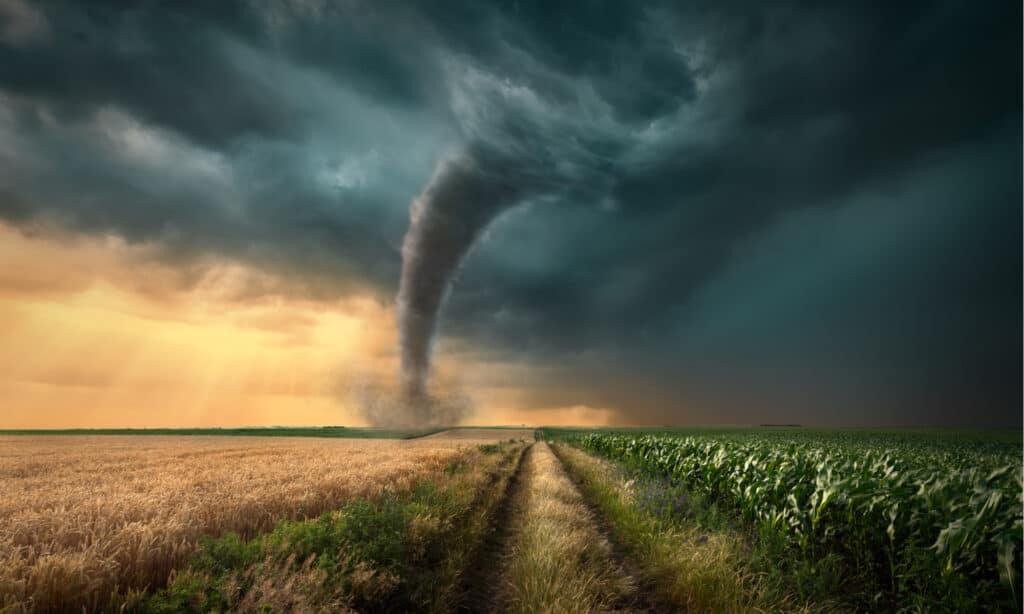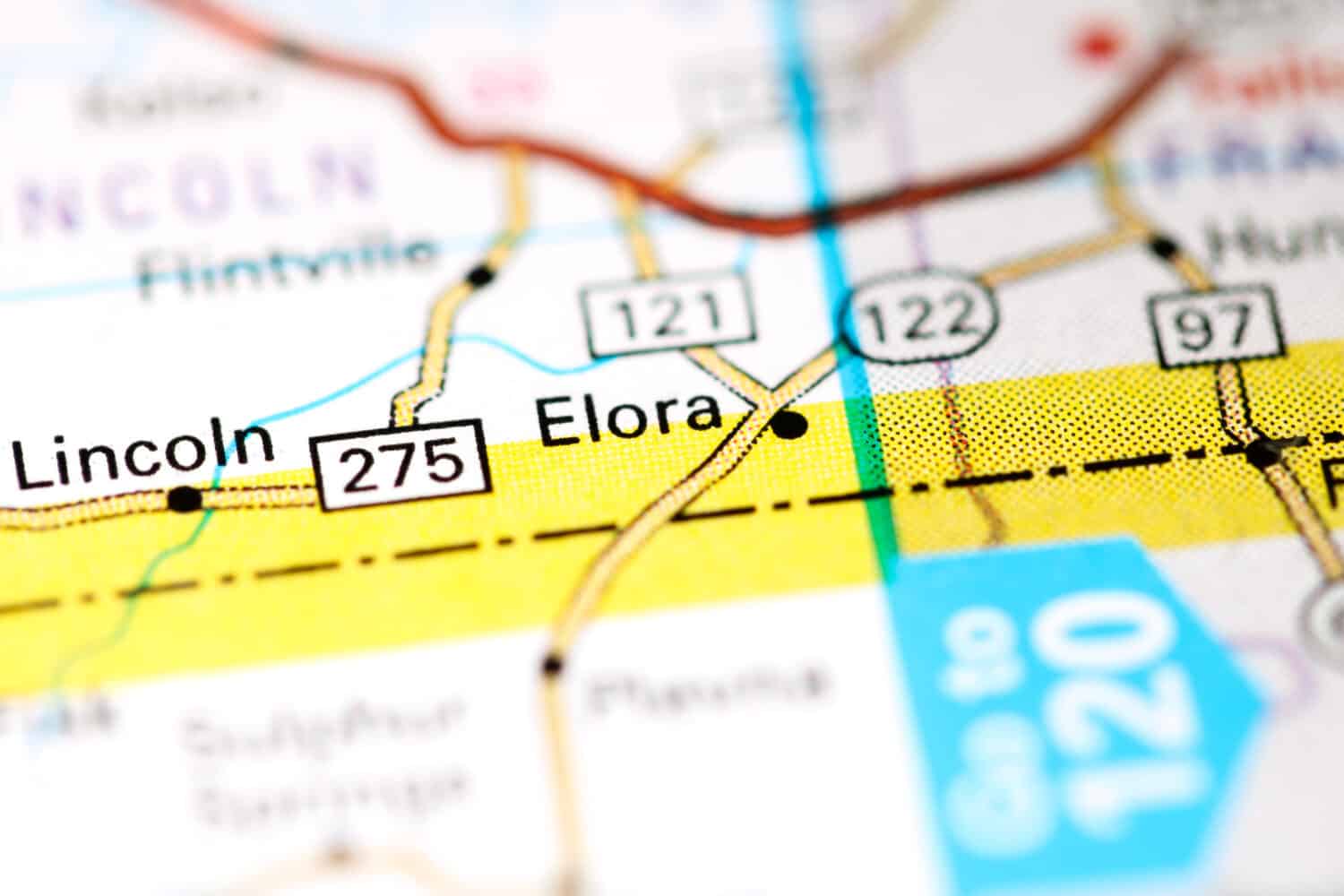While certain parts of Tennessee experience more tornadoes, dangerous and unpredictable twisters plague the entire state. However, the winds develop increasingly fast near major cities like Memphis and Nashville. Luckily, the Volunteer State is not part of Tornado Alley, but it does form part of Dixie Alley, a name given to areas in the USA with more risk of developing tornadoes. Sadly, Dixie Alley reports more death due to its high population inhabiting a small area and the large community of mobile homes. Most tornadoes in Tennessee occur in the spring. This number is more than the state sees during summer, fall, and winter. Furthermore, almost 2/3 of the tornadoes in the state occur in mid-Tennessee.

Tornadoes generally appear right after a storm.
©Rasica/Shutterstock.com
How Tornadoes Are Measured
The intensity of a tornado is not solely estimated on measured wind speeds because these natural disasters rarely pass near meteorological instruments. So, instead, analyzing the damage to structures and correlating the destruction with the wind speeds needed to create severe damage calculates their intensity. This method assigns values to tornadoes on the EF-Scale of tornado intensity or Enhanced Fujita Scale. The idea for this scale was first developed in 1971 by Japanese American meteorologist T. Theodore Fujita. Thereafter, the USA and several other countries used this method of measuring tornadoes. However, there were limitations to Fujita’s scale, which didn’t go unrecognized, like:
- Lack of substantial correlations between wind speed and observed damage.
- No recognition of regional variations in quality and types of construction of otherwise similar structures.
- Lack of substantial damage indicators for several building types that occur in modern society.
Unfortunately, historical records show inconsistencies with the rating of tornado intensity, and wind speeds were overestimated. Therefore, 33 years after the original Fujita Scale was presented, a new measurement called the Enhanced Fujita Scale was adopted in 2007. While this scale retains a lot of features from the original one, the higher intensity values are more precise. Furthermore, forecasters and scientists worked out how to adjust the older records, providing more accurate evidence for comparison.
The EF Scale separates the intensity of tornadoes into six categories ranging from EF0 to EF5. As a result, they are divided into three categories, weak, strong, and violent.
Weak Tornadoes (EF0 and EF1)
Luckily weak tornadoes account for 60 to 70% of all twisters, with only 5% fatalities. These tornadoes resemble a long, upward-opening cone and smooth surface with a single funnel cloud. Furthermore, it is common for the cone to stay airborne and not touch the ground.
Strong Tornadoes (EF2 and EF3)
Around 35% of tornadoes fall into the strong category, resulting in 30% of fatalities. These twisters have wide columnar funnel clouds. In addition, the surface of the funnel generally has a rapidly changing, rough texture that reflects small-scale turbulence. Since tornadoes typically form around or in strongly rotating updrafts, they extend into generating thunderstorms and may persist through the storm’s full height.
Violent Tornadoes (EF4 and EF5)
EF4 and EF5 tornadoes are rare. For example, only around 2% of tornadoes reach the high intensity needed to be labeled as violent. But, unfortunately, they result in 65% of all fatalities. The core of a violent tornado has a broad core, around 0.3 miles in diameter or more. Furthermore, the core’s center is calm and has a clear eye.
The Tennessee Town Most Likely to Be Hit By a Tornado
Elora is the Tennessee town most likely to be hit by a tornado. The unincorporated community of Elora lies in Lincoln County, Tennessee. It is located around two miles north of the Alabama state line and 16 miles southeast of Fayetteville. It ranks 1st on the tornado index for Tennessee, with a total score of 299.02.

Elora, Tennessee ranks 15th on the tornado index.
©SevenMaps/Shutterstock.com
The History of Elora, Tennessee
This town was initially named Baxter Station, and it was established in the 1850s as a stop along the Fayetteville and Decherd Branch Railroad.
Where Does Tennessee Rank On the Tornado Index?
Tennessee ranks 15th on the tornado index. On average, the Volunteer State experiences 31 twisters a year, which sounds like a lot, but compared to other states, it is not that much. For example, the average for Oklahoma is 68 tornadoes a year.
Population of Elora
Elora might be the Tennessee town most likely to be hit by a tornado, but it has a tiny community with a population of only 1,565 residents.
Wildlife Around the Tennessee Town Most Likely to Be Hit By a Tornado
There is an abundance of wildlife surrounding the Tennessee town, most likely to be hit by a tornado. Some animals living in the area include:
- Turkey vulture
- American bullfrog
- Red-tailed hawk
- Coyote
- Red fox
- Bobcat
- Long-tailed weasel
- American Beaver
- Northern cottonmouth
- Eastern Copperhead
While high-intensity tornadoes destroy human lives, they also impact the wildlife in the area in the following ways:
Flash Flooding
The number one cause of fatalities associated with thunderstorms and tornadoes is flash flooding. However, its impact on nature is just as severe. Flash floods destroy animals’ food supply and habitats and spread hazardous chemicals and materials into the environment of indigenous wildlife. For example, after a tornado has wreaked havoc, a massive amount of industrial and household waste is washed into the rivers, lakes, and stormwater drains, impacting the area’s fauna and flora.
Household Hazardous Waste
If a tornado destroys homes, there is an immediate danger of hazardous household products becoming exposed during the destruction of urban areas. Therefore, these products can affect the fauna and flora in the surrounding area. These dangerous products include:
- Household cleaning products
- Insecticides
- Automotive products
- Herbicides
- Workshop supplies like paint strippers and paint
These products can contaminate the soil and water, resulting in a toxic environment for humans, animals, and plants.
Asbestos Debris
The debris from asbestos is one of the most dangerous artificial materials that can affect people and animals after a tornado. So, if there are a lot of sheds and homes built from asbestos in the area, it can result in a large deposit of asbestos into the ground and atmosphere. While this toxic material is very harmful to humans, it also poisons animals by finding its way into their habitats and water supply. Furthermore, tornadoes can spread this hazardous material over great distances, which is difficult to locate and clean up because it breaks into small pieces.
Lightning
Unfortunately, lightning strikes often accompany tornadoes, which can cause forest fires and uproot or destroy old trees providing indigenous wildlife a home.
Forest and Bush Fires
As mentioned above, lightning strikes can cause forest fires during or after a tornado passes through the area. These fires severely affect animals by destroying their habitat and wiping out their shelters and food sources. Furthermore, the area takes several seasons to recover. Finally, and the most devasting outcome, many animals can’t make it out in time and perish in the fires.
Final Thoughts
Unfortunately, Elora is the Tennessee town most likely to be hit by a Tornado. While the town doesn’t boast a huge population, the impacts of a strong or violent tornado can be devastating. But, these twisters don’t only affect the human residents; they also cause severe damage to the surrounding environment, which in turn, affects the wildlife. So, while tornadoes demolish homes, infrastructure, and agricultural land, they also destroy animals’ habitats, which results in the loss of food sources. Luckily, most of the tornadoes that occur in Elora, Tennessee, are categorized as EF2s, so the damage is minimal. However, every few years, a category EF4 passes through this quaint town and wreaks havoc amongst the residents and wildlife.
Where is Elora Located on a Map?
Elora is a community located in Lincoln County, Tennessee, in the United States. It is found about 16 miles southeast of Fayetteville and around 2 miles north of the Alabama state line. Elora has its own post office with the zip code 37328.
Here is Elora on a map:
The photo featured at the top of this post is © EmiliaUngur/Shutterstock.com
Thank you for reading! Have some feedback for us? Contact the AZ Animals editorial team.






